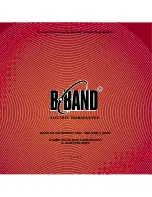
SWRS037B – JANUARY 2006 – REVISED MARCH 2015
5.9.3
Amplitude Modulation
CC1150 supports two different forms of amplitude modulation: On-Off Keying (OOK) and Amplitude Shift
Keying (ASK).
OOK modulation simply turns on or off the PA to modulate 1 and 0 respectively.
The ASK variant supported by the CC1150 allows programming of the modulation depth (the difference
between 1 and 0), and shaping of the pulse amplitude. Pulse shaping will produce a more bandwidth
constrained output spectrum.
NOTE
The OOK/ASK pulse shaping feature on the CC1150 does only support output power up to
about –1 dBm. The DEVIATN register has no effect when using ASK/OOK.
5.10 Forward Error Correction with Interleaving
5.10.1 Forward Error Correction (FEC)
CC1150 has built in support for Forward Error Correction (FEC) that can be used with CC1101 at the
receiver end. To enable this option, set MDMCFG1.FEC_EN to 1. FEC is only supported in fixed packet
length mode, that is, when PKTCTRL0.LENGTH_CONFIG=0. FEC is employed on the data field and CRC
word in order to reduce the gross bit error rate when operating near the sensitivity limit. Redundancy is
added to the transmitted data in such a way that the receiver can restore the original data in the presence
of some bit errors.
The use of FEC allows correct reception at a lower Signal-to-Noise RATIO (SNR), thus extending
communication range. Alternatively, for a given SNR, using FEC decreases the bit error rate (BER). As
the packet error rate (PER) is related to BER by
.
PER = 1 – (1 – BER)
packet_length
(4)
A lower BER can be used to allow longer packets, or a higher percentage of packets of a given length, to
be transmitted successfully.
Finally, in realistic ISM radio environments, transient and time-varying phenomena will produce occasional
errors even in otherwise good reception conditions. FEC will mask such errors and, combined with
interleaving of the coded data, even correct relatively long periods of faulty reception (burst errors).
The FEC scheme adopted for CC1150 is convolutional coding, in which n bits are generated based on k
input bits and the m most recent input bits, forming a code stream able to withstand a certain number of
bit errors between each coding state (the m-bit window).
The convolutional coder is a rate 1/2 code with a constraint length of m = 4. The coder codes one input bit
and produces two output bits; hence, the effective data rate is halved. This means that in order to transmit
at the same effective data rate when using FEC, it is necessary to use twice as high over-the-air data rate.
24
Detailed Description
Copyright © 2006–2015, Texas Instruments Incorporated
Product Folder Links:
Summary of Contents for CC1150
Page 61: ...PACKAGE OPTION ADDENDUM www ti com 30 May 2018 Addendum Page 2 ...
Page 64: ......
Page 65: ......















































